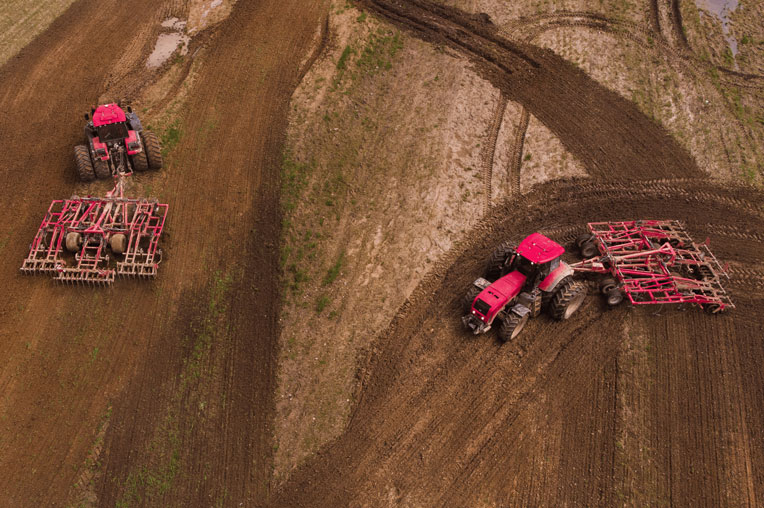Soil is an essential material and resource for farming and agriculture. Choosing the proper cultivation techniques and using state-of-the-art technology can help gain and retain the long-term profitability of the soil. A vital factor for a successful crop yield is seedbed preparation.
Let’s have a glance at the objectives of seedbed preparation.
Objectives of Seedbed Preparation
The primary objective for preparing a seedbed is to create a feasible atmosphere for seeds to grow efficiently and for quick seed germination. The prepared soil structure (tilth) should remain stable from tillage to harvest. After primary tillage, the land almost gets ready for optimum plant development.
Since the seeds which have been sown and are germinating in the soil need heat, water, and air to develop, it is necessary to make the surface soil soft enough for the seedlings to grow through.
It is important to re-solidify the area under the seeds to facilitate capillary action and supply water to the plant. These are the objectives of a well-prepared seedbed, the foundation required for a better crop yield.
Here’re some of the tasks to prepare a seedbed.
Tasks for Seedbed Preparation
- Create uniform conditions for sowing by levelling the surface.
- Use the equipment to break up clods, lumps and crumbs.
- Determine the size distribution of the soil aggregates for aggregate-size distributions and the creation of long-term structural soil stability.
- Till the soil to a consistent working depth.
- Creation of a large enough pore volume in the topsoil to ensure an adequate water supply and air to the plant roots.
- Adequate reconsolidation of the soil under the seeds to ensure proper seed germination in the initial stages.
So, preparing a seedbed means creating an appropriate atmosphere for a suitable medium for seedling germination, establishment, and growth. We can use several methods for optimal seedbed preparation.
The deciding factor in choosing an approach is considering the soil type, land condition, crop type, and how various techniques manage harvest residues. Since the seedbed lays the foundations for crop establishment, you must thoroughly examine the different methods to create a perfect seedbed for your crops.
Below are some of the standard techniques of seedbed preparation:
- Conventional technique
- Minimal tillage
- Shallow tillage
- Ultra shallow tillage
- Direct drilling
- Mouldboard ploughing + Rapid drilling
Remember, the use of these techniques depends on multiple factors, including soil type, climate, harvest residues, equipment used, labour requirements, etc.
Techniques for Seedbed Preparation
Conventional Technique
It involves ploughing in straw, cultivation to sowing depth with a tine/disc cultivator, conventional drilling, and fertiliser spreading.
Minimal Tillage
Here is the tillage of straw by the cultivator, drilling with Rapid, where seed and fertiliser are placed simultaneously in the soil/straw layer.
Ploughing in of Straw
Shallow cultivation, drilling with Rapid where seed and fertiliser are placed in the soil simultaneously.
Shallow Tillage
It is a shallow burial of straw at the surface, drilling with Rapid, where seed and fertiliser are placed simultaneously in the soil/straw layer.
Direct Drilling
This drilling is done with Rapid, where seed and fertiliser are placed simultaneously without prior soil tillage. The straw remains on the surface.
Technologies for Optimal Seedbed Preparation
New farmers may wonder about the different technologies used for seedbed preparation. Determining the farming machinery can be frustrating for small- and mid-size farmers.
Knowing the basics of farm equipment can be extremely helpful, even though all available equipment may seem overwhelming. If you want to purchase new or used farm equipment, this guide greatly helps. In this blog, we will discuss the different agricultural machines.
Here are some technologies used for different purposes with the end goal of preparation of the seedbed:
Farming Vehicles
Tractors
Traditionally, tractors were used to pull farm equipment, but modern tractors can be outfitted with various attachments to suit just about any farming need. For this reason, farmers of all sizes are wise to purchase tractors. Here are the common tractor types:
- Compact tractors
- Wheeled tractors
- Track tractors
- Orchard tractors
Tractor Attachments
Tractor attachments are attached to or pulled behind tractors to add a new level of functionality. They are widely used for soil management and seeding. Below are some types of attachments:
Plough
Plough is an important agricultural implement used to turn and break up the soil, bury crop residues, and help control weeds. Ploughing is one of the first steps of seedbed preparation.
Here are the common types of the plough:
- Mouldboard ploughs
- Disc ploughs
- Chisel ploughs
Harrow
In agriculture, a harrow is a farm implement used to till the soil. It is used to pulverise the soil, break up crop residues, uproot weeds, cover the seed and smooth out the surface of the soil.
Some common types of harrows include:
- Disc harrows
- Tine harrows (including spring-tooth, drag, and spike harrows)
- Roller harrows
- Chain harrows
In addition to the above technologies for seedbed preparation, there are a lot of others, including fertiliser spreaders, seeders, balers, farm wagons and trailers. Other than these attachments, there are many attachments that we are unable to cover in this blog.
Quick Sum Up
Hopefully, you have learned the techniques & technologies for optimal seedbed preparation. If you are a novice farmer or want improvements in soil structure, soil carbon build-up, the best use of soil moisture, integrated weed management and improved economic margins, count on Kelly Tillage. We are a family business with strong values and believe in manufacturing premium quality products, a better seedbed for a better bottom line.


